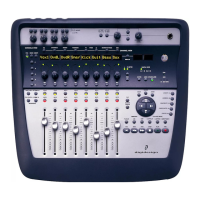
Do you have a question about the DigiDesign Digi 002 and is the answer not in the manual?
| Type | Audio Interface |
|---|---|
| Form Factor | Desktop |
| Channels of I/O | 18 |
| A/D Resolution | 24-bit |
| Bit Depth | 24-bit |
| Microphone Preamps | 4 |
| Phantom Power | Yes |
| Computer Connectivity | FireWire |
| Software Compatibility | Pro Tools LE |
| Control Surface | Yes |
| Transport Controls | Yes |
| Sample Rate | 48 kHz |
| Digital Inputs/Outputs | ADAT, S/PDIF |
| MIDI I/O | In/Out |
| Faders | 8 |
Details on regulatory compliance and standards for interference and EMC.
Essential safety precautions for using electronic equipment.
Details on included items and the capabilities of Digi 002 and Digi 002 Rack units.
Introduction to Pro Tools LE, its capabilities, and system requirements.
Information on product registration, user guides, and online resources.
Steps for initial setup, testing, and optimizing Windows system configurations.
Procedures for connecting hardware and installing Pro Tools LE software.
Guidance on launching, configuring Pro Tools LE, and managing related software.
Tips for optimizing hard drives and uninstalling Pro Tools.
Steps for installing and configuring Pro Tools LE on a Macintosh.
Connecting the Digi 002/Rack and configuring FireWire devices.
Adjusting Pro Tools LE settings and managing software.
Explanation of the different operational states of the Digi 002 unit.
Description of the main sections and controls on the Digi 002 top panel.
How Digi 002 controls adapt to different views (Home, Console, Channel).
Details on faders, switches, encoders, and scribble strips.
Controls for navigating and editing parameters like pan, sends, and inserts.
Overview of controls for session playback, navigation, and display functions.
Controls for setting input levels and signal types for the Digi 002 Rack.
Options for routing outputs and monitoring alternate input sources.
Explanation of LEDs indicating sample rate, connection status, and MIDI activity.
Information on audio levels, signal headroom, and supported sample rates/resolutions.
Details on all analog and digital input/output connectors and formats.
Information on connecting MIDI devices, FireWire peripherals, and footswitches.
Details on power connectors, switches, and connection status indicators.
Steps for connecting the Digi 002/Rack to a computer and external drives.
Instructions for connecting headphones and monitor speakers for audio monitoring.
Methods for connecting analog and digital audio sources to the interface.
Connecting external effects devices and monitoring alternate audio sources.
Connecting recorders for mixdowns and setting up MIDI devices.
Fundamentals of creating, managing, and navigating Pro Tools LE sessions.
Steps for recording audio and MIDI, playback, and latency management.
Techniques for editing, arranging, and comping audio and MIDI regions.
Using channel strip controls, sends, returns, plugins, and mix automation.
Process of bouncing to disk and creating final audio mixes.
Capabilities, settings, and modes for operating Digi 002 as a stand-alone mixer.
Configuring digital I/O and navigating mixer controls in stand-alone mode.
Using built-in EQ, Dynamics, and managing delay/reverb sends.
Saving and loading mixer configurations using snapshots.
Steps to resolve startup issues and optimize system performance.
Adjusting system settings like network cards and processor scheduling for performance.
Disabling unnecessary startup applications to free up system resources.
Overview of the ASIO driver, its compatibility, and usage without Pro Tools.
Procedures for installing and uninstalling the Digidesign ASIO Driver.
Adjusting ASIO driver settings, including buffer size and hardware setup.
Overview of the WaveDriver for third-party audio playback and compatibility.
Procedures for installing and uninstalling the Digidesign WaveDriver.
Setting up WaveDriver for QuickTime Player, Media Player, and third-party apps.
Controlling third-party application access via the WaveDriver Opt-In list.
Overview of the CoreAudio driver and its known limitations.
Information on CoreAudio driver compatibility and default installation.
Adjusting buffer sizes, hardware setup, and manager preferences for CoreAudio.
Setting up system preferences for CoreAudio-compatible applications.
Overview of the MIDI Studio Setup window and its interface controls.
Managing instruments, editing properties, and configuring MIDI channels.
Using XML files for importing and managing MIDI patch names.
Using Apple's Audio MIDI Setup to identify and configure MIDI devices.
Connecting MIDI devices and naming them within AMS.
Configuring MIDI channels and assigning device icons for custom display.
Signal flow diagram for input channels 1-4 in stand-alone mode.
Signal flow diagram for inputs 5-8, master faders, sends, and outputs.
